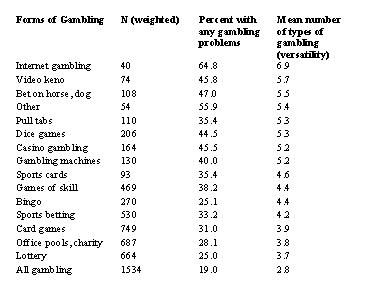The WAGER, Vol. 14(5) – What’s in a game? Are certain types of gambling more likely to lead to disordered gambling?
At present, research findings are mixed about the impact of specific forms of gambling on gambling-related problems. Using limited samples, some studies have found an association between specific gambling activity and disordered gambling (e.g., Wood & Griffiths, 1998), often implicating gambling machines as especially “addictive” because of their high rate of gambling opportunities. Treatment seekers often report disproportionate rates of play on specific games. However, treatment seekers are not representative of others with similar problems. Therefore, it is not surprising that some researchers (e.g., National Research Council, 1999; Welte, Barnes, Wieczorek, Tidwell, & Parker, 2004) have found that the number of gambling activities is more predictive of problem gambling. This week’s WAGER reviews a study that examines the relationship between specific forms of gambling and gambling-related problems among a nationally representative sample of U.S. youths (Welte, Barnes, Tidwell, & Hoffman, 2009).
Methods
- Participants were U.S. youths (ages 14-21) selected via random digit dialing of household telephone numbers who completed the National Survey of Youth and Gambling (N = 2,274).
- Interviews assessed past year gambling behavior and gambling-related problems.
- Investigators used a researcher-developed survey to assess participant involvement in 15 gambling activities or settings.
- Investigators evaluated gambling-related problems using the South Oaks Gambling Screen Revised for Adolescents (SOGS-RA).
Results
- Sixty-eight percent of study participants (N=1,535) reported gambling during the previous twelve months; the highest percentage of these gamblers reported engaging in card games (33%), office pools and charitable gambling (30%), and the lottery (29%).
- Table 1 summarizes the risks for gambling-related problems and gambling versatility (i.e., mean number of types of gambling in which respondents engaged) for each gambling activity/setting.
- Overall, higher levels of gambling versatility were associated with more gambling-related problems.
- Researchers performed incidence risk ratio analyses to investigate the impacts of engaging in particular forms of gambling while controlling for all other types of gambling behavior.
- After controlling for involvement in other games/settings, card games, games of skill, gambling at casinos, and ‘other’ gambling were associated with an increased risk of gambling-related problems.
- Other gambling types, including Internet gambling, were not associated with increased risk when controlling for involvement in other gambling activities.
Table 1. Prevalence of Any Gambling Symptoms and Gambling Versatility on All Forms of Gambling for Gamblers Who Played Each Form of Gambling, U.S. Youth and Gambling Survey (Adapted from Welte et al., 2009)
Limitations
- Self-report of gambling activity involvement and potential problem gambling behavior can be associated with recall and reporting bias.
- Data was collected using random digit dialing of household phones, which only occasionally included cell phones. This strategy generally limits the study sample to youths with a landline home telephone. This group might not be representative of the youth population segment.
- Study questions did not distinguish gambling settings from specific forms of gambling (e.g., questions were asked about casino gambling and about gambling machines not in a casino but not about gambling machines in casinos).
Conclusion
The findings from this study do not support the idea that the most rapid forms of gambling, such as gambling machines, are the most problematic type of game. The finding that gamblers who had higher gambling versatility (i.e., experience with more types of gambling) were more likely to experience gambling problems is, however, consistent with previous research (e.g., National Research Council, 1999; Welte et al., 2004) showing that overall gambling involvement is a more useful predictor of gambling-related problems than participation in specific gambling types. A high correlation between a specific type of gambling (e.g., Internet gambling) and problem gambling does not reflect a causal influence; this association might mean that devotees of that type of gambling also engage in a lot of other gambling. Youth gambling prevention and harm reduction programs might benefit by incorporating the findings of this study into their practices. Specifically, by focusing less on particular types of gambling and focusing more on the potential risks of high levels of gambling engagement, such programs might better prevent or reduce the harms associated with youth problem gambling behavior.
-Erica Marshall
What do you think? Please use the comment link below to provide feedback on this article.
References
National Research Council. (1999). Pathological gambling: A critical review. Washington D.C.: National Academy Press.
Welte, J., Barnes, G., Tidwell, M., & Hoffman, J. (2009). The association of form of gambling with problem gambling among American youth. Psychology of Addictive Behaviors, 23(1), 105-112.
Welte, J., Barnes, G., Wieczorek, W., Tidwell, M., & Parker, J. (2004). Risk factors for pathological gambling. Addictive Behaviors, 29(2), 323-335.
Wood, R. T., & Griffiths, M. D. (1998). The acquisition, development and maintenance of lottery and scratchcard gambling in adolescence. Journal of Adolescence, 21(3), 265-273.
